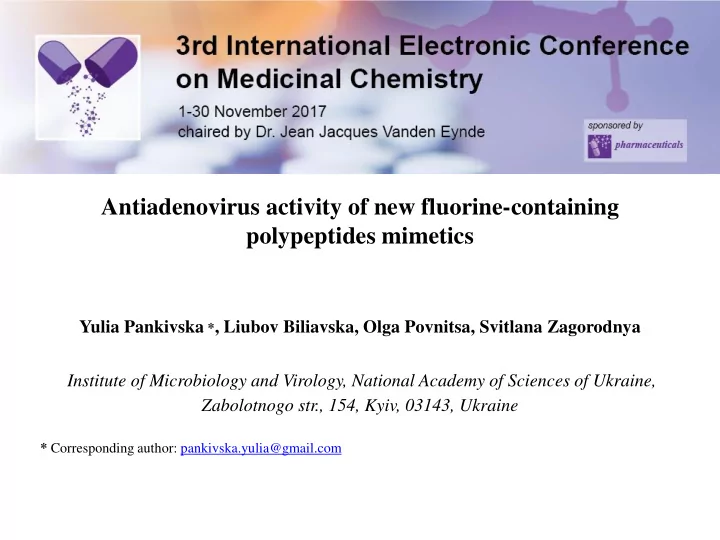

Antiadenovirus activity of new fluorine-containing polypeptides mimetics Yulia Pankivska * , Liubov Biliavska, Olga Povnitsa, Svitlana Zagorodnya Institute of Microbiology and Virology, National Academy of Sciences of Ukraine, Zabolotnogo str., 154, Kyiv, 03143, Ukraine * Corresponding author: pankivska.yulia@gmail.com
Abstract: More than 60 serotypes cause a variety of courses and severe clinical signs of infectious disease. However, there is no specific drug for the treatment of adenoviral diseases. The studying of fluorinated nucleoside sugars chemistry became the basis for the development of promising chemotherapeutic agents with antitumor and antiviral effects. Based on the purine and pyrimidine nucleotide analogs and fluorinated heterocycle molecules a number of new generation drugs with anticancer effect was developed. The reference strain of human adenovirus serotype 5 and monolayer cell line MDBK were used in the experiment. We studied new fluorine-containing compounds 10S-25 (1-S-thio-(1- methylsulfonyl-2-difluoromethyl-vinyl)-2,3,4,6,-tetra-O-acetyl- β -D-glucopyranose), 10S-26 ((S)- (1- (β -D-glucopyranosyl)- 2-(ethoxydifluoromethyl)-pyrrolidine hydrochloride), 10S-27 4- (hexafluoropropyl)-5-tosyl-1H-1,2,3-triazole), 10S-28 (Dimethyl N,N'-(2,2- difluoropropanedithioyl)bis(L-alaninate)), synthesized in Institute of Organic Chemistry of the NAS of Ukraine. Antiviral activity and the effect on adenovirus synthesized de novo were investigated. Cytotoxicity of experimental compounds was within 16 - 637 μg /ml. Antiviral activity was maximal for compound 10S-27 in the concentration of 16 μg /ml (36%). Other experimental compounds had less antiviral activity in all concentrations. However, they had a significant influence on the synthesis of viral offspring. The percentage of virus inhibition titer was in the range of 65-92%. Therefore, the experimental compounds affected the formation of the infectious viral offspring. Keywords: adenovirus, fluorine-containing compounds, antiviral activity.
Introduction • Human adenoviruses cause various acute diseases including gastrointestinal and respiratory disorders. • However, there are no clinically approved specific anti-adenoviral drugs. • Based on the purine and pyrimidine nucleotide analogues and fluorinated heterocycle molecules a number of new generation drugs with antiviral and anticancer effect were developed. • Therefore, the search of drugs and regimens that would be effective, safe for prolonged use, and available at a cost for a wide range of patients is extremely important.
Test compounds Novel fluorine-containing compounds were studied: • 10S-25 (1-S-thio-(1-methylsulfonyl-2- difluoromethyl-vinyl)-2,3,4,6,-tetra-O-acetyl- β - D-glucopyranose), 10S-26 10S-25 • 10S-26 ((S)-2-(ethoxydifluoromethyl)- pyrrolidine hydrochloride), • (1- (β -D-glucopyranosyl)-4- 10S-27 (hexafluoropropyl)-5-tosyl-1H-1,2,3-triazole), • 10S-27 10S-28 (Dimethyl N,N'-(2,2- difluoropropanedithioyl)bis(L-alaninate)), synthesized in Institute of Organic Chemistry of the NAS of Ukraine. 10S-28
Cytotoxicity of test compounds CC 50 indexes Cytotoxicity of the compounds was determined by MTT-test according to the standard protocol. 700 637 600 Concentration, μ g/ml 541 Inoculated cell culture MDBK (bovine 500 kidney) were used for this procedure. 400 300 250 200 Cytotoxicity of experimental compounds 16 100 was within the range of 16 - 637 μg /ml. 0 10S25 10S26 10S27 10S28
Antiviral activity of tested compounds ( was determined by MTT-test) 10S-26 10S-25 30 40 % of virus inhibition 35 25 % of virus inhibition 30 20 25 15 20 15 10 10 5 5 0 0 125 62 31 16 8 4 2 1 Concentration, μ g/ml Concentration, μ g/ml 10S-28 10S-27 40 33 35 32 % of virus inhibition % of virus inhibition 30 31 25 30 20 29 15 28 10 27 5 26 0 25 125 62 31 16 125 62 31 16 Concentration, μ g/ml Concentration, μ g/ml
Influence of the compounds on virus synthesized de novo ( was determined by MTT-test) 76 95 % of reduction of virus titer % of redaction of virus titer 90 74 85 72 80 70 75 70 68 10S-25 10S-26 65 66 60 64 55 62 50 4 2 1 125 62 31 Concentration of the compound, μ g/ml Concentration of the compound, μ g/ml 73 80 % of reduction of virus teter % of reduction of virus titer 72 70 60 71 70 50 40 69 10S-27 10S-28 30 68 20 67 10 66 62 31 16 0 Concentration of the compound, μ g/ml 125 62 31 Concentration of the compound, μ g/ml
Discussion • The test compounds showed low antiviral activity. • However, the effect of the compounds on the titer of the virus synthesized de novo indicates that the compounds affect the formation of infectious virus progeny. • As a result, it can be assumed that fluoride-containing mimetics affect the viral DNA. Although virus offspring are formed, virus particles are not complete, and they are not able to cause an infection process.
Conclusions • The cytotoxicity of fluorine-containing compounds 10S-25, 10S-26, 10S-27, 10S28 was studied. CC 50 indexes were within the range of 16 - 637 μg /ml. • Antiviral activity against adenovirus serotype 5 was also investigated. Percentage of inhibition of the virus ranged from 3 to 36 %. • Fluorinated mimetic polypeptides showed a significant inhibitory effect on the virus titer synthesized de novo . Percentage of inhibition was in the range of 60- 92%.
Recommend
More recommend